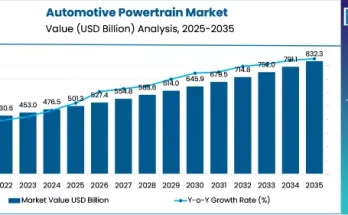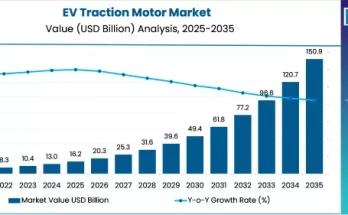The global e-bike motor market is entering a rapid growth phase, fueled by the rising adoption of electric mobility, government support for clean transportation, and significant advances in battery and motor technologies. According to recent insights, the market was valued at US$ 28.4 billion in 2023 and is projected to expand at a robust CAGR of 16.5%, reaching US$ 150.3 billion by 2034. This strong growth trajectory highlights the increasing role of e-bikes in urban commuting, recreational activities, and eco-friendly transportation worldwide.
From pedal-assist motors to hub-driven and mid-drive systems, the industry is advancing with innovative solutions that enhance performance, efficiency, and rider experience. This article explores the dynamics, drivers, trends, opportunities, challenges, and regional outlook shaping the global e-bike motor market over the next decade.
Market Overview
The e-bike motor market encompasses a variety of motor technologies, including hub motors, mid-drive motors, and dual-drive systems, each catering to distinct use cases from city commutes to off-road adventures. These motors not only improve riding efficiency but also enhance accessibility for diverse age groups, making e-bikes a popular alternative to traditional bicycles and cars.
As environmental concerns and urban congestion intensify, e-bikes powered by advanced motors are emerging as sustainable and practical solutions for modern mobility needs. Integration with smart technologies, improved torque control, and lightweight designs are pushing the sector into mainstream adoption.
Key Market Drivers
Rising Demand for Sustainable Transportation
Growing awareness of climate change and government-led incentives for electric mobility are accelerating e-bike adoption. Consumers are turning to e-bikes as cost-effective and eco-friendly alternatives to conventional vehicles.
Technological Advancements in Motors
Manufacturers are investing in lightweight, high-efficiency motors with smart connectivity features, enhancing overall rider experience and range. Innovations in battery management systems are also improving performance and reliability.
Urbanization and Traffic Congestion
Cities worldwide are facing severe congestion and pollution. E-bikes, equipped with powerful motors, provide a convenient, fast, and sustainable mobility solution, particularly for last-mile connectivity.
Health and Fitness Consciousness
E-bikes offer a blend of exercise and convenience, appealing to health-conscious consumers. The pedal-assist feature allows riders to enjoy physical activity with adjustable motor support.
Government Support and Infrastructure Development
Subsidies, tax benefits, and infrastructure initiatives—such as dedicated cycling lanes and charging stations—are bolstering the global demand for e-bike motors.
Market Trends
- Mid-Drive Motor Dominance
Mid-drive motors are gaining popularity due to their balanced weight distribution, higher efficiency, and superior torque performance compared to hub motors. - Integration of Smart Features
Connectivity features like GPS tracking, app integration, and adaptive motor control are enhancing user experiences, making e-bikes more attractive to urban riders. - Lightweight & Compact Designs
Continuous R&D is driving the development of compact, lightweight motors that improve maneuverability and reduce overall e-bike weight. - Premiumization and Performance
High-end e-bikes equipped with advanced motors are witnessing growing demand among sports and adventure riders, creating a strong premium segment. - Shared Mobility and Rental Models
The expansion of e-bike sharing platforms is contributing to the adoption of efficient, durable motors designed for commercial usage.
Challenges Facing the Market
High Initial Costs
Despite long-term benefits, the upfront cost of advanced e-bike motors remains a barrier for price-sensitive consumers.
Supply Chain Vulnerabilities
Fluctuating raw material prices and disruptions in the supply of key electronic components can impact production scalability.
Regulatory Differences Across Regions
Inconsistent regulations regarding e-bike classifications and speed limits pose challenges for global manufacturers.
Consumer Awareness
Educating consumers about the performance and environmental benefits of e-bike motors is crucial for broader adoption.
Applications & End-use Outlook
- Urban Commuting: Adoption is surging in metropolitan areas where traffic congestion and parking constraints drive e-bike use.
- Recreational & Sports: E-bikes with powerful motors are being embraced for mountain biking, trekking, and leisure activities.
- Commercial Usage: Logistics, food delivery, and shared mobility services are increasingly deploying e-bikes for last-mile delivery solutions.
- Tourism: Rental fleets equipped with efficient motors are expanding across tourist hubs, promoting eco-tourism.
Regional Insights
- North America: Strong growth driven by government incentives, urban mobility initiatives, and rising consumer health awareness.
- Europe: A dominant market supported by cycling culture, sustainability regulations, and advanced infrastructure in countries like Germany, the Netherlands, and France.
- Asia-Pacific: Fastest-growing region with high adoption in China, India, and Japan. Affordable models and urbanization trends are fueling market expansion.
- Latin America & Middle East: Emerging markets where growing awareness of eco-friendly transport is creating new opportunities.
Competitive Landscape
The global e-bike motor market is highly competitive, with multinational players and regional manufacturers striving for market leadership. Key companies profiled include:
- Ananda Drive Technology (Shanghai) Co., Ltd.
- Brose Fahrzeugteile GmbH & Co. KG
- Dapu Motors
- NIDEC CORPORATION
- Panasonic Corporation
- Robert Bosch GmbH
- Shimano Inc.
- Suzhou Bafang Electric Motor Science-Technology Co. Ltd.
- Suzhou Xiongda Motor Co. Ltd.
- TDCM Corporation Limited
- TRANZX
- Yamaha Motor Co. Ltd.
- Other Prominent Players
These companies are focusing on portfolio expansion, strategic collaborations, smart motor technologies, and eco-friendly solutions to strengthen their market positioning.
Future Outlook
The global e-bike motor market is set to witness exponential growth through 2034, driven by the convergence of sustainability, technology, and urban mobility demands. Integration with AI-powered systems, IoT-enabled tracking, and advanced energy management will define the next wave of innovation.
Companies that align with consumer values—sustainability, affordability, and performance—will emerge as leaders in this transformative decade.
Conclusion
The e-bike motor market is not just an industry trend; it represents a shift toward greener, smarter, and more inclusive mobility solutions. With strong growth projections and expanding adoption across urban and recreational segments, e-bike motors are set to play a pivotal role in reshaping global transportation.
By investing in innovation, sustainability, and user-centric designs, manufacturers can unlock vast opportunities and drive the future of sustainable mobility.



